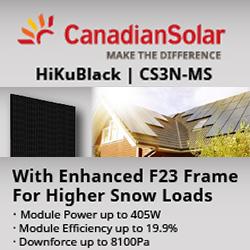New, More Efficient Geothermal Heat Pumps Require Longer Loop Systems
Properly sized geothermal equipment and loop systems are critical to maximize heating and cooling efficiency.
Over the past few years, thousands of geothermal heat pump systems have been installed across Canada responding to the demand for more cost-effective, energy efficient and renewable heating and cooling solutions for home and business.
What we have learned as an industry along the way is how important it is to select the right sized equipment and loop systems to maximize heating and cooling efficiency. By designing the right system from the outset, we ensure that home and business owners reap the benefits of their geothermal system for years to come.
Never will system design be more important than in the coming year. A number of geothermal manufacturers and distributors, including my own company, GeoSmart Energy, are on the verge of introducing new heat pump equipment that is set to raise the bar on energy efficiency. Some companies are boasting that their new equipment will increase today's energy efficiency by as much as 30 per cent.
Supporting this new level of efficiency means we will need to rethink how we design our loop systems.
When used for heating, geothermal heat pumps are rated by their COP (Coefficient of Performance), measuring both the combination of mechanical energy from the electricity needed to run the machine with the heat energy extracted from the ground. When sized properly, combined they total the energy necessary to heat a home or building.
In the past, we used proportionately a lot more electricity and less extracted energy from the ground than we do today. Over the years, with advances in geothermal technology, we gradually introduced more energy efficient equipment, and as we did, we began to rely less on electricity component and more on energy extracted from the ground by the equipment to achieve our goals.
For example, ten years ago, it took 20,000 BTUs (5.86kw) of electricity and 40,000 BTUS of energy from the ground to heat a home requiring a heating output of 60,000 BTUs, resulting in a COP of 3.
Today, with more efficient equipment design, that same house has a COP of 4, using 15,000 BTUs (4.39kw) of electricity and 45,000 BTUs of energy from the ground.
In the coming year, we're going to see the introduction of geothermal equipment that pushes the envelope on energy efficiency, moving us towards a COP of 6. For the first time ever, we're going to see a reduction in our reliance on electricity to as little as 10,000 BTUs 2.93kw) while the energy being absorbed from the ground reaches 50,000 BTUs.
It's great news that we're becoming more savvy when it comes to harnessing energy from the ground to heat and cool our buildings. But as this new, more efficient equipment hits the market, our increasing reliance on the earth's energy means we need to pay even closer attention to the loop designs that will best support these new systems.
As we decrease the amount of electricity used to run the heat pump and rely more heavily on the earth's energy, we will need longer or larger loop systems to reduce undue stress on the ground. What we're going to see in the future to support these more efficient systems are different loop configurations and enhanced grouting practices.
The industry has seen several new and rehashed older helical vertical loop ideas in the past year as well as new lake loop and horizontal boring technology. Unfortunately most vertical ideas are unsuccessfully attempting to provide equal or better performance in smaller ground spaces. Shallow loops are dramatically affected the fluctuating annual moisture level found in unconsolidated formations and by the regional outdoor ambient temperature limiting reliable performance. Long term high performance is best served by deeper more the thermally stable rock formations below. This is great news for the drilling industry as the more efficient geothermal equipment and re-designed loop systems should lead to the need for more specialized drilling than ever before.
When this new equipment hits the market later this year, the geothermal industry will be working hard to ensure that contractors, drillers and installers are aware of the importance of loop design in supporting these new systems.
Selecting the right sized equipment and loop systems to maximize heating and cooling efficiency hasn't changed. What has changed is that with equipment becoming more efficient, there's an even greater focus now on designing the right loop systems to ensure maximum performance from these new systems and minimal stress to the ground.
Stan Marco is a well-respected and highly sought after geothermal knowledge expert and educator. He is an active member within the ground water community, is a board member with the Canadian GeoExchange Coalition and is Co-founder and CEO of GeoSmart Energy & GeoSmart Drilling Services.
Featured Product

Canadian Solar - HiKuBlack - Black Backsheet & Frame (Mono)
Aesthetic appearance for residential systems: With black backsheet & black frame, Power range 380 ~ 405 W, Low power loss in cell connection. Enhanced reliability: · Low temperature coefficient (Pmax): -0.34 % / °C, LID LeTID less than 2.0%, Lower hot spot temperature, Better shading tolerance.
